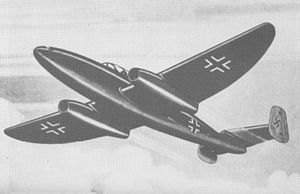Heinkel He 280
| He 280 | |
|---|---|
 |
|
| Heinkel He-280 V2. | |
| Role | Fighter |
| Manufacturer | Heinkel |
| Designer | Robert Lusser |
| First flight | 22 September 1940 |
| Status | Cancelled |
| Produced | 1940–1943 |
| Number built | 9 |
The Heinkel He 280 was the first turbojet-powered fighter aircraft in the world. It was inspired by Ernst Heinkel's emphasis on research into high-speed flight and built on the company's experience with the He 178 jet prototype. A combination of technical and political factors led to it being passed over in favor of the Messerschmitt Me 262. Only nine were built and none reached operational status.
The Heinkel company began the He 280 project on its own initiative after the He 178 had been met with indifference from the Reichsluftfahrtministerium (German, Reich Aviation Ministry, RLM). The head designer was Robert Lusser, who began the project under the designation He 180 in late 1939. It had a typical Heinkel fighter fuselage, elliptically-shaped wings and a dihedralled tailplane with twin fins and rudders. The landing gear was of the retractable tricycle type with very little ground clearance. This arrangement was considered too frail for the grass or dirt airfields of the era; however, the tricycle layout eventually gained acceptance. The Me 262 was originally designed as a tail-dragger, but this configuration makes it difficult for a jet to become airborne, and the Me 262 entered production with a redesigned tricycle landing gear. The He 280 was equipped with a compressed-air powered ejection seat, the first aircraft to carry one and the first aircraft to successfully employ one in an emergency.
...
Wikipedia
